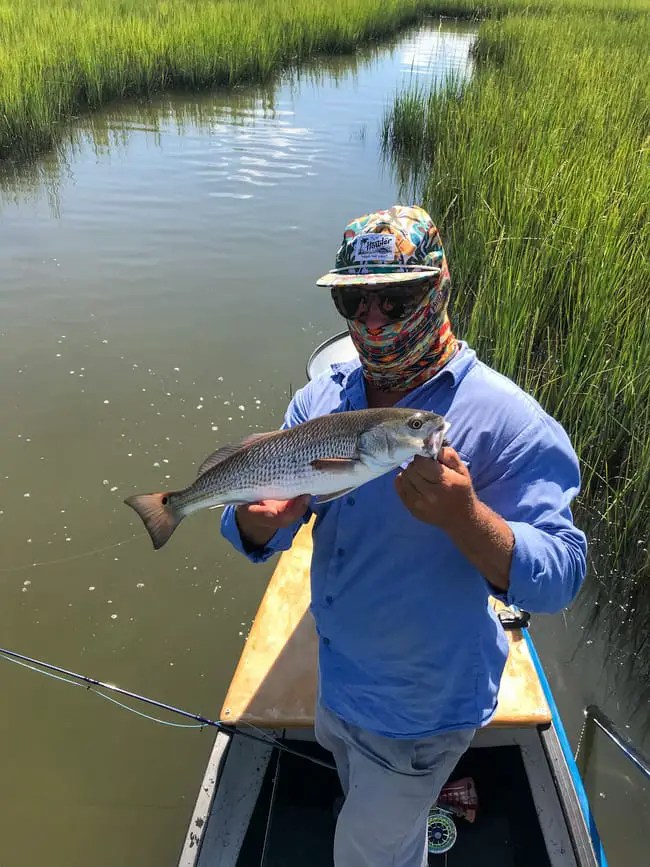Not everyone can afford or has access to a boat. Canoes are an easy way to expand your reach on the water. Yes, you can cover more ground with a canoe, but can you actually fly-fish from a canoe?
Fly-fishing from a canoe is not only possible but often a preferred method. A canoe can open up places to fish that boats are unable to reach like shallow water or narrow passages around mangroves and other brush. A canoe’s shallow draft and stealthiness make it a great option for fly-fishing.

There are many things to consider when fishing from a canoe. Even though you can fly fish from a canoe, it can be very challenging. In this article, I’ll review when it makes sense to fly fish from a canoe and some of the advantages and disadvantages of doing so. Additionally, we will discuss if other paddle crafts may be a better option for you.
Why would you fly-fish from a canoe?
For the non-boat owner, the answer is quite obvious. Having a canoe will open up a lot more areas for you to be able to fish. Many regions of the country have limited areas to fish from shore and having a canoe will allow you to venture into back bays or creeks.
Even for the boat owner, fly-fishing from a canoe can still make sense. There are times when it is not possible to reach shallow fish by boat. Having a canoe that drafts almost nothing will make reaching these areas possible.
Additionally, some of the greatest places to fish are designated as “No motor” zones. This means that any vessel with a combustible engine is prohibited from entering. In these areas, you are forced to use a paddle craft such as a canoe.
For example, one of the greatest places to fish on earth is the Florida Everglades. Large areas of the everglades are designated as no motor zones. Having access to a canoe and even being able to put it on the boat will help you reach these areas. No motor zones tend to be pristine habitats and hold an abundance of fish.
Oftentimes, we will strap the canoe to the boat, anchor up outside of the no motor zone, and paddle or push pole the canoe into these areas. I personally have had some of my greatest fishing days pushing a canoe through these areas.

What are the advantages of fishing from a canoe?
There are many reasons to use a canoe over a traditional boat or by fishing from land.
Shallow Draft
The main advantage of the canoe is its shallow draft. Anywhere there is water is reachable for the canoe. If you happen to get stuck, you can simply get out and push or pull it. You will quickly realize that you are able to go further than any boat, and can reach untouched areas to fish.
Ability to be stealthy
Another advantage of the canoe is the ability to remain stealthy. A canoe has a very small footprint in the water and can be pushed or paddled with stealth to avoid spooking fish. Sneaking up on fish in a canoe is a lot easier than moving a larger boat or using a trolling motor that makes noise in the water.
Little maintenance
Lastly, maintaining and using a canoe is easy. Since there is no engine and usually not a trailer, there is not any routine maintenance that needs to be done. You can simply put the canoe in the back of a truck or strap it to the top of a car and you are off. When you are finished fishing, a quick spray with the hose and you are all set.
Disadvantages of choosing to fly fish from a canoe
Fishing from a canoe can be great, but it is not always easy. There are quite a few challenges to overcome before you start catching fish on your canoe.
Stability
A canoe is a simple-designed vessel that is typically rounded down below the waterline. Additionally, they are not very wide. Being that this is the case, they tend to not be very stable. Learning to balance on a canoe will take some time and agility to master. Do not be surprised if you end up in the drink a couple of times while figuring it out.
Since fly-fishing is far easier to do while standing up, an additional challenge will be learning to balance while standing in the canoe. For a younger angler, this may not be a big issue. As we age, our ability to be agile on a boat decreases. Making a fly-casting motion in an unstable boat will be a challenge, and can affect the accuracy of your cast. Practice will make this a lot more comfortable for you.
Manual propulsion
You are the motor when fishing from a canoe. You will need to be able to paddle the canoe to the spots or use a push pole to push yourself there. This can be quite tiring, especially if paddling a long distance. If you add in some tidal movement or heavy winds, a good workout is in store for you.
Trying to time your paddle to go downwind or with the tide will make the adventure a lot more enjoyable. When possible, you should launch the canoe as close to the area you want to fish as possible. Having the ability to put the canoe on a boat will make getting to areas a whole lot easier.
The ability to quickly stop
Fish tend to pop up when you least expect them. When fishing from a boat, the added weight and new technologies make stopping the boat quickly far easier than when using a canoe.
Fishing from a boat allows you to use a trolling motor, which can lock you in a spot. For more information on trolling motors, check out Do trolling motors have reverse? Another nice feature of a boat is having a power pole. A power pole is a hydraulic stake that will stab into the ground in seconds with the push of a button. This allows you to spot fish and quietly anchor at a moment’s notice.
Since a canoe is a very light, small vessel, it is more easily influenced by wind and currents. This will make stopping a canoe quickly very challenging. Instead you better off quickly putting down your paddle or pole and trying to make a quick cast while you have the opportunity. This will take some practice to perfect.
Limited storage
There are no fancy storage compartments on a canoe-like there is on a boat. Oftentimes your fishing gear will spread out on the floor in front of you. Your rod will also be laying in the bottom of the boat while you wait to cast.
As you can imagine this will make maneuvering around the canoe much more difficult. Since a canoe is already very small, moving around the vessel without breaking or stepping on gear will only add to the frustration of fishing from a canoe.
Using storage bins, like a milk crate, for tackle will be helpful. Also modifying the canoe where possible to add rod holders and push pole/paddle holders will make life much easier. Creating a designated standing space with a spot for all your gear easily reachable around you is a must. The idea should be moving around the canoe as little as possible.

Is fishing from a kayak a better option?
In some aspects, fishing from a kayak may be easier. Kayaks tend to be flat on the bottom which makes them far more stable. Most kayaks are designed to be used sitting down, but many have adopted layouts for standing up. This added stability makes it far easier to stand up and throw a fly rod. The design layouts also make it easier to use fly-line management devices such as a mat or a bucket.
Kayaks have also evolved quite a bit over time and since kayak fishing has become very popular, manufacturers are now designing kayaks specifically for fishing. These kayaks tend to have storage compartments for tackle and some even have a live well for storing bait when fishing conventionally.
One of the biggest advantages to a kayak is the ability to have foot pedal paddling. Similar to a bike, there are two pedals that will drive you forward. In fact, some kayaks can also be steered this way by having a foot-controlled rudder. This allows you to be hands-free while moving, which in turn, allows you to cast while moving.
If you are a fisherman that enjoys traditional fishing in addition to fly-fishing, the kayak will be a better option for you. Also, if you have balance issues, the stability of the kayak over the canoe will also be beneficial.

Can you fly-fish on a paddleboard?
One of my favorite ways to fly-fish is from a paddle board. Since they are designed to be stood on, they tend to be very stable.
I have found that fly fishing is easiest when using a paddleboard. The flat deck design makes it the easiest to manage your fly line and the fly rod can be placed in front of you at your feet. There is a limited amount of space, making this ideal for someone who does not bring a lot of gear with them. A small box of flies, a fly rod, and a paddle are about all you would want to carry.
Being that the board is flat and usually only a couple of inches above the waterline, it is easier to lose things over the side. This is another reason you want to pack light. Again this is the best option for the minimalist.
There are paddle boards designed specifically for fishing. These boards have a place to put a cooler to sit on and store drinks and tackle. Fishing boards also have an option to add a tackle rack that has built-in rod holders for storing your rods while moving around. Some of the fancier paddle boards have “Stick it” anchor mounts, for quick anchoring, and places to quickly stow the paddle so you can grab your rod faster.

The one thing to consider when paddleboarding is the draft. Since a paddleboard is similar to a surfboard, it uses a large fin to keep you tracking straight. This will add draft to the paddleboard and will cause them to draft around 6”. This will be greater than the draft of the paddleboard or kayak that simply have the boat in the water. Shorter fins can be purchased or the existing fin can be cut down to lower the draft. While on a paddleboard fishing, you are not making large turns like when using one in the ocean, therefore very little fin is needed in the water to maneuver around.
Conclusion
You can fly fish from a canoe to explore remote areas and will open the doors to greater versatility for the shore fishermen. Some of my best days fly-fishing have been in a canoe in no motor zones.
Although it is a lot of fun, there are quite a few challenges. Anytime you are fishing from a small unstable vessel, the degree of difficulty will be greater. Overcoming these challenges will become easier with practice.
Fly fishing from paddle craft is not only limited to canoes. Kayak fishing and paddleboard fishing have become very popular and in some cases may be a better option for you. Having a canoe, kayak, or paddleboard is a great idea, even if you have a boat.
